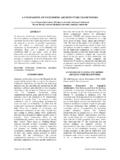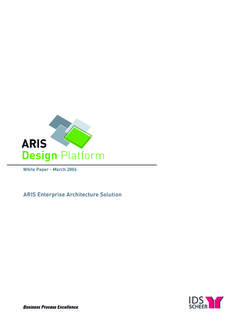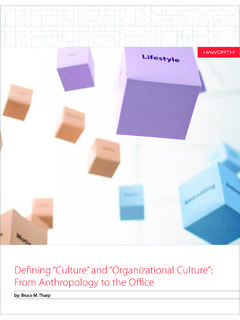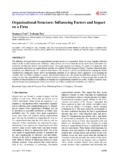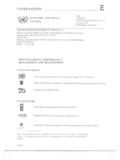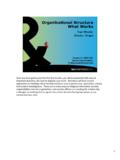Transcription of UNICEF Organizational Review
1 UNICEF Organizational Review Synthesis Report Findings and Summary Recommendations 25 May 2007 Prepared and Submitted by: Box 8904 Falls Church, VA 22041-8904 Page 2 of 48 25 May 2007 Table of Contents Page # PART ONE: Review BACKGROUND, EXTERNAL TRENDS, AND DIAGNOSTIC FINDINGS I. Background & Purpose of the Organizational II. Emerging Trends in Development and the Aid III. Findings of the Organizational Review IV.
2 Strategic Imperatives for PART TWO: Organizational Review RECOMMENDATIONS V. Context: Shape UN Coherence to Ensure Delivery of Results for VI. Sharpen Programme Focus, Formulation & VII. Realign Structures and Systems to Deliver Quality VIII. Position UNICEF as a Global Knowledge Leader for IX. Enhance Partnerships for Resources and X. Manage for XI. Page 3 of 48 25 May 2007 Part One: Review Background and Diagnostic Findings I. BACKGROUND AND PURPOSE OF THE Organizational Review In October of 2005, UNICEF announced the intent to conduct an independent Review of the global organization to help assess UNICEF s Organizational health and to build a new foundation for continuous improvement going forward.
3 Given the many changes internally (new senior leadership, growth and diversification of UNICEF resources, continued expansion of UNICEF field offices) and a changing external context (trends in the development and aid environments, as well as the renewed impetus for UN Coherence), this was an opportune time to conduct a broad-based strategic Review . The Request for Proposal called for the Review to focus on three main themes to help position UNICEF for maximum impact in the future: 1) a participatory Organizational assessment to highlight strengths, weaknesses, and strategic opportunities; 2) articulation of a strategic direction built upon UNICEF s comparative advantages and partnership opportunities; and 3) an Organizational design that combines cohesive structures, efficient systems and processes, and robust internal capacity to deliver on the strategic vision.
4 The Organizational Review would also provide an opportunity to integrate the multiple exercises underway that had targeted specific elements of the organization, including: Strategic Review of Human Resources Supply Function Evaluation Global Integrated Resource Mobilization Strategy Innocenti Research Centre Evaluation Civil Society Partnership Review Gender Parity Study Business Process Review Following a competitive bidding process, GivingWorks Inc. was selected in March 2006 to conduct the Organizational Review . A dedicated counterpart team in UNICEF led by a senior UNICEF and UN colleague was also established to work with the consultants. While many organization-wide reviews are conducted in response to Organizational crisis or major external discontinuity, UNICEF proactively initiated this Review , not because it was in crisis, but rather to build on its numerous past successes and to capitalize on opportunities to achieve maximum results for children over the next 10 to 15 years, especially the achievement of the Millennium Development Goals by 2015.
5 This report, prepared by GivingWorks, draws on a year of extensive analysis, consultations, and reflection. The report highlights a number of emerging trends in the development environment and aid architecture , presents the assessment findings of the Organizational Review diagnostic, and provides a summary of the consultants recommendations and their underlying rationale. While the report has benefited from extensive comments from management, the views expressed here are those of the consultants and not necessarily of UNICEF . Page 4 of 48 25 May 2007 II. EMERGING TRENDS IN DEVELOPMENT AND THE AID architecture During the diagnostic phase, the Organizational Review highlighted a number of important emerging trends and issues in the broader aid and development environments that may substantially impact UNICEF s priorities, engagement strategies and business model in the future.
6 These key trends represent not only emerging issues for children and women, but also shifts within the aid architecture and the landscape of development actors. Looking first at the well-being of children and women, a number of clear trends have emerged which will influence UNICEF s programmatic priorities over the coming years. The world has seen much progress for children over the past 20 years, including a substantial reduction in the child mortality rates, a significant reduction in the number of deaths from infectious diseases, an increase in the number of children attending school, and a gradual recognition of child rights as a global commitment. There is also a renewed acknowledgment that issues of child health, education and protection are often intertwined, and that relevant solutions need to be articulated at all levels from international and national policies to the community, to the household and the individual.
7 The Millennium Declaration and the associated Millennium Development Goals have proven to be important expressions of this international consensus. Other trends are not as encouraging. The need for humanitarian assistance is likely to continue and grow for years to come. Natural disasters have increased in incidence and severity in recent years, and current projections on climate change suggest increases in the number and frequency of extreme weather events, rising sea levels, and adverse impacts on water supplies and crop Armed conflict and conflict-based instability represent a continued area of concern given the prevalence of sectarian violence, terrorism, and religious and ethnic tensions in many parts of the world, including the continued recruitment of youth and child soldiers into rebellion and resistance movements.
8 Even in non-crisis situations, physical security of children and women is a critical concern, evidenced by the recent UN Secretary-General s Study on Violence Against Children which highlighted the extent of physical abuse, sexual exploitation, and other rights abuses in the home, school and community. While mortality due to infectious disease continues to decline, injuries are gaining more attention as a cause of children s deaths in certain parts of the world, particularly in emerging and middle income countries. Middle Income Countries have grown as a group and have enjoyed a rising international profile in recent These countries represent a diverse group that face complex economic, social, cultural, political, and development challenges and an unfinished social agenda that includes meeting and exceeding the Millennium Development Goals.
9 Inequality remains a critical issue in several countries, as poverty and exclusion from social services tend to be regionally or ethnically concentrated. Many countries must also overcome significant capacity gaps in building transparent and accountable public institutions at the national and sub-national levels. The complexities associated with rapid economic growth, transition from state to market- 1 Number of annual disasters with 10 or more killed or 100 people affected grew from ~250 in the mid-1990 s to nearly 500 in 2004 (International Disasters Database: EM-DAT). 2 The World Bank defines middle-income countries as having a per capita income of between US$1,025 and US$6,055 for fiscal 2007.
10 Page 5 of 48 25 May 2007 based economies, and changes social norms and in young people s behavior are further straining institutional and service delivery capacities. Furthermore, the drivers of economic growth in many of these countries are weak, and some of these countries are at risk of falling back into low-income Recent economic growth and private resource inflows have decreased the reliance of these countries on financial support from donors. Instead, they are increasingly interested in access to normative guidance and high-quality technical expertise tailored to their specific needs. Middle Income Countries also play an increasingly important role in the development of other countries, as repositories of extensive experience in what works and what does not, and as contributors to global public The development context and in particular the issues of children in these countries are significantly different than those in the traditional programme countries.











